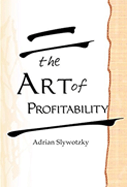Corentin Derbré
Books:

The Art of Profitability – Adrian Slywotzky
ISBN: 0446692271
Date read: 2017-07-19
How strongly I recommend it: 9/10
(See my list of books, for more.)
Go to the Amazon page for details and reviews.
Helps seeing in depth how business generate profit, with great examples. And the writing is exquisite, told as a teaching story. It also includes a lot of great book recommendations and exercises.
my notes

The Art of Profitability – Adrian Slywotzky
ISBN: 0446692271
Date read: 2017-07-19
How strongly I recommend it: 9/10
(See my list of books, for more.)
Go to the Amazon page for details and reviews.
Helps seeing in depth how business generate profit, with great examples. And the writing is exquisite, told as a teaching story. It also includes a lot of great book recommendations and exercises.
my notes
Which specific actions can my organization take in the next ninety days to improve our profit position?
The pathway to profitability? It lies in fully understanding the customer.
Being able to take the measure of the world is one of the most crucial skills we can develop.
“Front-end loading?” “Yes. It’s the opposite of cramming for an exam, or writing the term paper in the last forty-eight hours.” “Meaning—?” “You put the cramming up front. You squeeze the maximum reading into the first forty-eight hours rather than the last. You practice total immersion, early. Read as much as you can as fast as you can, read till you get a headache, and keep reading. And you do all this at the beginning of the project. “Here’s what happens. You build a structure of knowledge that’s incomplete but very powerful. Why? Because every new fact or idea or hypothesis you run into later gets integrated into an evolving structure that keeps getting stronger over time.”
Google: “Hilbert” with the S learning curve
But I’ve learned not to take setbacks too personally. Otherwise you burn up a lot of energy in irritation and anger, which tends to lead to further mistakes.
Phil Areeda, the great Harvard Law School contracts professor, who was better than anyone in driving and leading the student further, always to the next question, always one level deeper.
“Our first big breakthrough came in March, when a project leader gave a presentation to the portfolio review team that killed his own project. Three million dollars a year of spending got shut down. “Ann responded brilliantly. She promoted the project leader and reassigned the talent on the project to important assignments on lead projects. The organization got the signal. In the next two months, ten more projects folded. We were down to a total of forty.
They never say ‘No’ to the customer, but they do tell the customer how much it will cost.
wired effect? p.72b
“There are four levels to learning: Awareness. Awkwardness. Application. Assimilation.”
“The open door syndrome?” “Yes. You work for years to open the door to the kind of opportunity that matters—and then you don’t walk through it.”
“A rainbow trout?” “Irresistibly drawn to the shining lure of the next thing that came up. Trout fall for the silver-glistening lure, and they get caught. We’re the same. Psychologically, it’s a fascinating moment, a zone of temporary economic insanity. We lose all sense of long-term self-interest, all sense of strategy, all sense of the really smart thing to do. It’s like entering an electromagnetic field that disables your compass.”
“If you’re going to become an investor, talk to customers. It’s as important for investors as it is for managers. It’s something that is always done poorly.” “Why is that?” “Two reasons. First, people ask the wrong questions. They go into conversations asking, ‘What do I need to know?’” “What should they be asking?” “They should ask, ‘What am I afraid to find out?’
Remember, always remember, he told himself, no bad student, just bad teacher.
martyrdom is b-o-r-i-n-g.